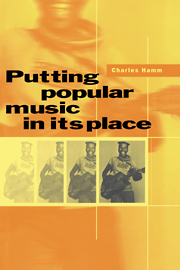Book contents
- Frontmatter
- Contents
- Acknowledgements
- Preface
- 1 Modernist narratives and popular music
- 2 Rock and the facts of life
- 3 Changing patterns in society and music: the US since World War II
- 4 “If I Were a Voice”: or, The Hutchinson Family and popular song as political and social protest
- 5 Some thoughts on the measurement of popularity in music
- 6 Elvis, a review
- 7 Home cooking and American soul in black South African popular music
- 8 Rock ‘n’ roll in a very strange society
- 9 African-American music, South Africa, and apartheid
- 10 “The constant companion of man”: Separate Development, Radio Bantu, and music
- 11 Privileging the moment of reception: music and radio in South Africa
- 12 Music and radio in the People's Republic of China
- 13 Towards a new reading of Gershwin
- 14 A blues for the ages
- 15 Graceland revisited
- 16 Dvořák in America: nationalism, racism, and national race
- 17 The last minstrel show?
- 18 The Role of Rock, a review
- 19 Genre, performance, and ideology in the early songs of Irving Berlin
- 20 Epilogue: John Cage revisited
- Index
15 - Graceland revisited
Published online by Cambridge University Press: 05 February 2012
- Frontmatter
- Contents
- Acknowledgements
- Preface
- 1 Modernist narratives and popular music
- 2 Rock and the facts of life
- 3 Changing patterns in society and music: the US since World War II
- 4 “If I Were a Voice”: or, The Hutchinson Family and popular song as political and social protest
- 5 Some thoughts on the measurement of popularity in music
- 6 Elvis, a review
- 7 Home cooking and American soul in black South African popular music
- 8 Rock ‘n’ roll in a very strange society
- 9 African-American music, South Africa, and apartheid
- 10 “The constant companion of man”: Separate Development, Radio Bantu, and music
- 11 Privileging the moment of reception: music and radio in South Africa
- 12 Music and radio in the People's Republic of China
- 13 Towards a new reading of Gershwin
- 14 A blues for the ages
- 15 Graceland revisited
- 16 Dvořák in America: nationalism, racism, and national race
- 17 The last minstrel show?
- 18 The Role of Rock, a review
- 19 Genre, performance, and ideology in the early songs of Irving Berlin
- 20 Epilogue: John Cage revisited
- Index
Summary
Around the time of my last visit to South Africa, some of the music I'd been studying there was in the process of being “discovered” by the outside world. Ladysmith Black Mambazo, Juluka, and other South African groups began receiving air play in Europe and North America; independent record companies such as Shanachie in the United States and Rough Trade in the UK released discs by other South African performers; rock journalists, from the Village Voice to The New York Times, displayed a sudden expertise in “African pop,” including South African varieties; long-time expatriate musicians Miriam Makeba and Hugh Masekela, who had performed in international jazz and pop styles since leaving South Africa, began reintroducing traditional African elements into their music; and Paul Simon released his Graceland album with backing tracks by South African musicians, some of them recorded during a furtive visit to Johannesburg.
As an acoustical phenomenon, the infusion of rhythmic vitality and clean sonorities from South African popular styles had a salutary, if temporary, impact on Western pop. Social meaning was more problematic, though. In Europe and North America, this music was incorporated into existing social structures, as a new variety of dance music. But many in the West also insisted on linking it with the black struggle for freedom in South Africa, using it in anti-apartheid rallies.
- Type
- Chapter
- Information
- Putting Popular Music in its Place , pp. 336 - 343Publisher: Cambridge University PressPrint publication year: 1995
- 1
- Cited by

